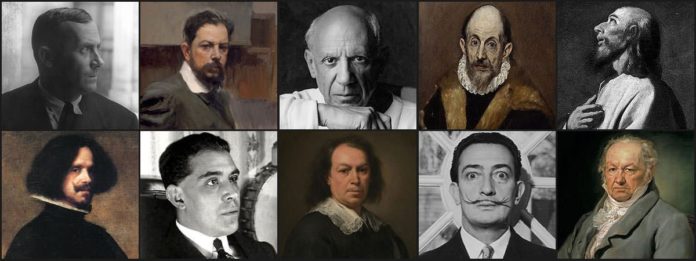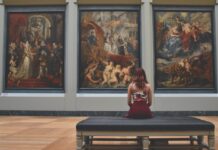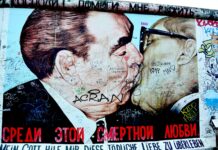
Spain has always been home for art lovers and has produced some of the most famous painters of all time, such as El Greco, Francisco Goya, Deigo Velazquez, Salvador Dali, and yes, Pablo Picasso!
Spanish painters’ style has evolved, and they have practiced all forms of art. In the 16th century, El Greco created the masterpiece “The Burial of Count Orgaz.” In the 17th century, Diego Velazquez emerged, winning over the hearts of art enthusiasts with his religious and imaginary paintings. Spanish art was dominated in the 18th century by Francisco Goya’s works. The 19th century was, however, a less spectacular time apart from Joaquin Sorolla, who came up with some fascinating works. In the 20th century, Spanish art reached the apex with the help of extremely gifted Spanish painters like Picasso, Gris, and Dali.
With this post, you can learn in detail about the most famous Spanish painters of all time.
El Greco

El Greco is considered as the originator of the Spanish Renaissance. He opted for conceptual art ahead of naturalism, Greco’s paintings inspired different movement. His works mostly had its subjects with elongated, tortured features.
Francisco de Zurbaran

Francisco de Zurbaran preferred to use a naturalistic technique to his regular depiction of different religious scenes. He worked for ecclesiastical commissions and earned an excellent reputation following the success of his works. Most of his religious paintings appeared simple, yet they had complex emotions.
Diego Velazquez

Diego Velazquez was nicknamed “the painter of painters.” He painted various nobles and members of the court, which endeared him to people when he was alive and after his lifetime. Velazquez also painted historical and cultural events. And his masterpiece “Las Meninas” is currently displayed in Prado Museum, Madrid.
Bartolome Esteban Murillo

Bartolome Esteban Murillo was regarded as one of the most famous religious painters of his generation. He also created paintings of modern women and children. Later in his career, his works were reshaped as he used vibrant paints and wide brushes.
Francisco de Goya

Francisco de Goya is regarded as the last from the Old artists and the pioneer of modern art. During the early stages of his career, Goya’s creation of royal portraits was widely celebrated, and in 1779, he was appointed as a royal court painter. His works got increasingly pessimistic and darker following an illness that totally deafened him, and his later paintings revealed his gloom. His work, “Caprichos and Los Disparates,” reflects the most frightening aspect of life.
Pablo Picasso

Pablo Picasso was skilled in several art forms and styles. He is known as an influential artist in Spanish art and helped to introduce abstract sculpturing. Best known for his mastery in Cubism, Surrealism, and Expressionism, Picasso’s innovative sceneries reshaped the face of art.
Joan Miro

Joan Miro drew his inspirations from exploring the human mind and was skilled in Surrealism, creating paintings, sculptures, and prints. He went against the conventional paintings techniques with his abstract paintings, which he perceived as the support of the middle-class society. This prompted him to declare the extinction of a non-representational type of art. His style evolved in the later stage of his career, from the tension of the poetic inspiration and his life’s vision. In addition to painting, Miro regularly practiced lithography and created several wall paintings, tapestries, and sculptures.
Salvador Dali

Salvador Dali is considered one of the famous artists of the 20th-century; he was a member of the Surrealist movement. Dali used the teachings of Freudian theory to create some of his outstanding and sophisticated works. It was perceived that his childhood memories and autobiography inspired the active themes of sensuality, death, and decay that often dominated his works.
Antoni Tapies

Antoni Tapies stands out as one of the most famous European painters of his generation. Tapies’s works reveal the experiences he had during the Spanish Civil War. The landscape of destroyed walls inspired his most famous works. His abstract paintings conform to the Art Informel tradition.
Eduardo Arroyo

The controversial self-taught painter often used his creations as tools to mock bullfighters, dictators, gentlemen, and even decorated artists such as Joan Miro and Marcel Duchamp. Arroyo created paintings, sculptures, and authored several stage sets. During the avant-garde test with abstraction, his creations were focused on Realism, Abstraction, and Expressionism. He borrowed his images from various sources, including Ads and graphic design. Arroyo’s famous photos are considered to have a blend of modern figuration and pop art.
Joaquín Sorolla y Bastida

Born in 1863, Sorolla shone in portraiture, landscape painting, and monumental creations that had historical and social themes.
Although Sorolla didn’t see formal portraiture as his preferred genre, because he felt it restricted his creativity, and he was disconnected from his subjects. He later found portrait commissions to be lucrative and went on to portray his family. His works were often influenced by Velázquez, as evident in “My Family,” which had his family in the foreground, with himself reflecting in a distant mirror, at work. His works were also inspired out of competition with his friend and painter John Singer Sargent, as evident in Mrs. Ira Nelson Morris and her children’s portrait.
Sorolla’s interest was perceived to be stirred by sunlight, and he found outdoors as his suitable portrait settings. This was evident in his daughter pose for María at La Granja as she stood in a bright landscape. This is also similar to the Portrait of the Spanish royalty, King Alfonso XIII, wearing a Hussar’s Uniform.
Sorolla was of significant influence to some other Spanish painters, like Alberto Pla y Rubio and Julio Romero de Torres, who were both labeled “sorollista.”
After he passed on, his widow, Clotilde García del Castillo, forfeited several of his works to the Spanish public. The paintings later formed the “Museo Sorolla” collection, which was the painter’s Madrid home. The museum inaugurated in 1932.
Sorolla’s work is displayed across museums and many private collections in Spain, Europe, and America. Ten of his Impressionist beach views were purchased in 1933 by J. Paul Getty, and most of them are now exhibited in the J. Paul Getty Museum.











